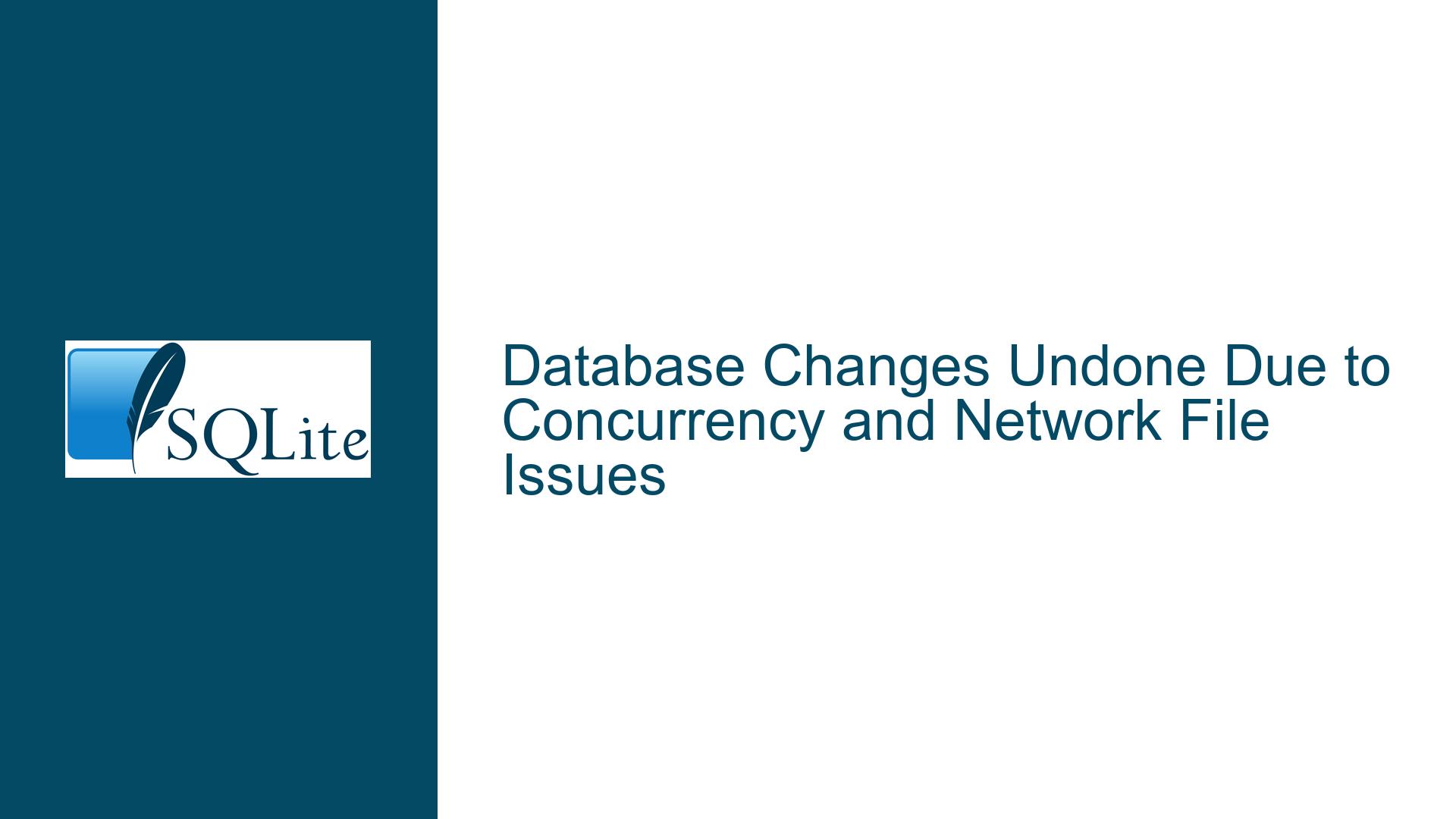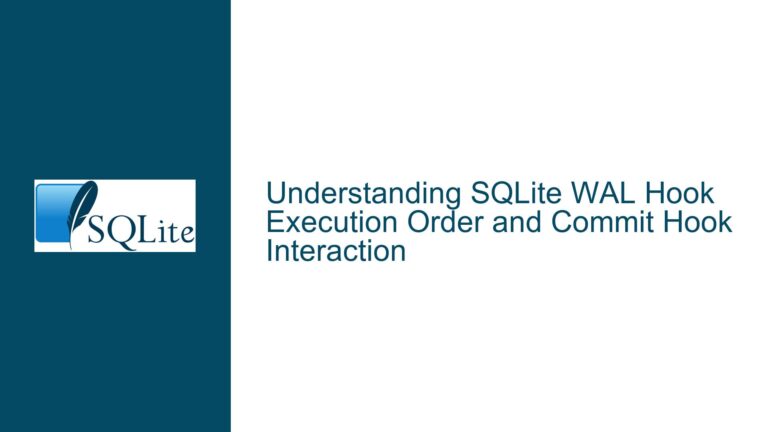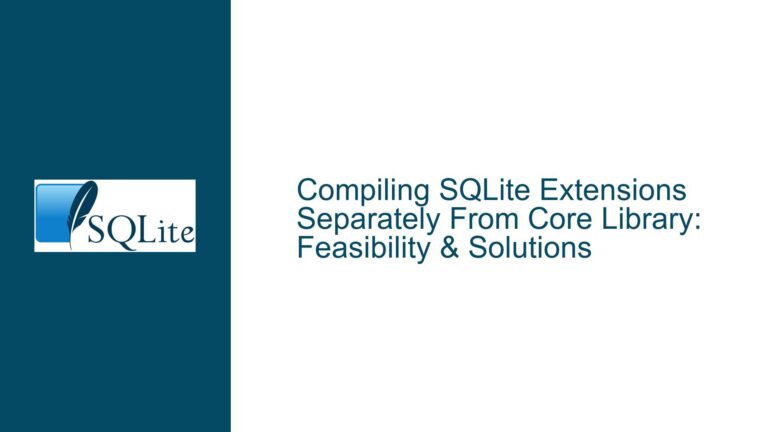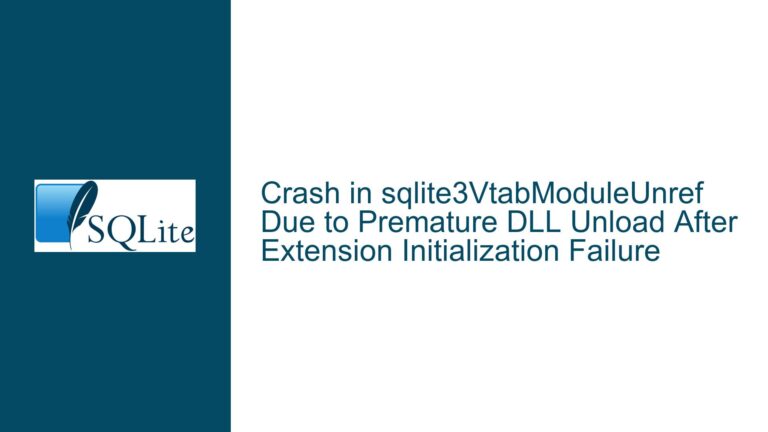Database Changes Undone Due to Concurrency and Network File Issues
Transaction Visibility Conflicts in Multi-App SQLite Environments
Concurrent Writes and Network Storage: Diagnosing Disappearing Data
Root Causes of Transaction Rollbacks and Data Inconsistencies
The core issue arises from concurrent write operations across multiple applications interacting with an SQLite database file stored on a network-attached storage (NAS) device. Three primary factors contribute to the observed behavior where committed changes appear to be "undone" or overwritten:
Network File System Locking Limitations
SQLite relies on file-system-level locking mechanisms to manage concurrent access. When the database resides on a NAS, these locking primitives often fail due to:- Delayed lock state propagation between clients
- Cached file handles maintaining stale views of database state
- Inconsistent implementation of POSIX file locking across SMB/NFS protocols
This creates race conditions where applications see partial database states despite using proper transaction semantics. A client writing to T2 and T3 might complete its transaction while another client’s subsequent writes to T1 use an older database snapshot that doesn’t include the T2/T3 changes, effectively creating temporal paradoxes in row ID sequencing.
Python DB-API Transaction Autocommit Behavior
The sqlite3 module employs automatic transaction management that conflicts with manual commit calls:# Implicit transaction state machine with sqlite3.connect() as conn: cursor = conn.cursor() cursor.execute("INSERT...") # Starts transaction if none active conn.commit() # Explicit commit # Connection closure triggers implicit rollback if transaction remainsThis dual-layer transaction control leads to phantom commits when:
- Multiple DML statements execute without explicit BEGIN/COMMIT blocks
- Connection pooling reuses handles with residual transaction states
- Exception handlers bypass commit/rollback calls before closure
SQLite Version Mismatch Across Applications
Mixed library versions (3.37.0 vs 3.31.1) introduce subtle incompatibilities in:- Locking protocol implementations (e.g., SHARED lock acquisition timing)
- Write-Ahead Log (WAL) mode handling
- Page cache invalidation heuristics
These discrepancies become critical when applications interleave writes through different SQLite runtime versions, particularly under network storage conditions.
Critical Failure Modes in Distributed SQLite Deployments
Four specific failure vectors combine to produce the reported anomalies:
Vector 1: NAS Caching Artifacts
Network file systems often implement aggressive read caching that violates SQLite’s atomic visibility guarantees. When App1 commits T1 insertions:
- App2 might read from a NAS cache showing pre-commit T1 state
- Subsequent App2 commits to T2/T3 get written to a database file that (from App1’s perspective) still shows older T1 rows
- NAS write coalescing reorders physical page writes across transactions
Vector 2: Python Connection Lifecycle Bugs
The posted code contains two dangerous patterns:
# App1's risky fetchone() after insert
cursor.execute(sql) # INSERT...
result = cursor.fetchone() # Only safe for SELECTs
con.commit()
This attempts to fetch results from an INSERT statement (which returns None), potentially leaving the cursor in an undefined state that interferes with commit operations. More critically:
# App2's cursor closure before commit
cursor.execute(...)
con.commit()
cursor.close() # Should close AFTER commit completes
Premature cursor closure can abort pending transactions in some sqlite3 versions when using network files.
Vector 3: Version-Specific Lock Hierarchy Changes
Between SQLite 3.31.1 and 3.37.0, significant locking optimizations were introduced:
- 3.36.0: Improved handling of BUSY states during concurrent writes
- 3.37.0: Modified WAL checkpointing thresholds
Mixed versions create scenarios where: - App1 (3.37) assumes certain lock wait timeouts
- App2 (3.31) uses older retry logic
Resulting in mutual lock bypasses that corrupt the transaction sequence.
Vector 4: File Handle Inheritance Across Processes
When applications spawn child processes (common in Python multiprocessing), network file handles may get inherited with inconsistent lock states. This manifests as:
- Child processes writing to parent’s transactional context
- Orphaned locks preventing proper version rollover
- Cross-process page cache collisions
Comprehensive Remediation Strategy for Stable Multi-App SQLite
Implement these solutions in sequence, validating after each step:
Step 1: Eliminate Network Storage Dependencies
Migrate the database to local storage on a dedicated host with these safeguards:
# On Linux hosts:
mv database.db /dev/shm/ # RAM disk for single-node access
chmod 660 /dev/shm/database.db
# Windows equivalent:
NET USE Z: \\localhost\C$\SQLiteDatabases /PERSISTENT:YES
If network storage is unavoidable, deploy a local proxy service:
App1 → Local Proxy (with SQLite) ↔ NAS
App2 → Same Proxy ↔ NAS
The proxy serializes all database access through a single SQLite process.
Step 2: Enforce Uniform SQLite Runtime Environment
Standardize library versions across all consumers:
# Verification script for Python environments
import sqlite3
assert sqlite3.sqlite_version_info >= (3, 37, 0), "Upgrade required!"
For embedded systems, compile a custom SQLite amalgamation with version locking:
// sqlite_custom.c
#define SQLITE_VERSION "Custom-3.37.0"
#define SQLITE_SOURCE_ID "..."
// Prevent dynamic linking
#pragma comment(linker, "/INCLUDE:_sqlite3_version")
Step 3: Implement Explicit Transaction Control
Replace implicit transactions with rigorous BEGIN/COMMIT blocks:
def safe_execute(conn, sql, params=None):
conn.execute("BEGIN IMMEDIATE")
try:
cursor = conn.cursor()
cursor.execute(sql, params or ())
conn.commit()
except sqlite3.Error as e:
conn.rollback()
raise
finally:
if conn.in_transaction: # Python 3.12+
conn.rollback()
Key modifications:
- Use BEGIN IMMEDIATE to acquire write locks upfront
- Verify transaction state before connection reuse
- Employ retry loops for BUSY errors:
MAX_RETRIES = 5
RETRY_DELAY = 0.1
for attempt in range(MAX_RETRIES):
try:
safe_execute(conn, "INSERT ...")
break
except sqlite3.OperationalError as e:
if 'database is locked' not in str(e):
raise
time.sleep(RETRY_DELAY * (2 ** attempt))
else:
raise TimeoutError("Lock contention unresolved")
Step 4: Connection Pooling with File State Verification
Maintain a connection pool that validates database state before reuse:
from sqlite3 import connect
from filelock import FileLock
class DBConnectionPool:
def __init__(self, db_path, pool_size=5):
self.db_path = db_path
self.pool = [connect(db_path) for _ in range(pool_size)]
self.lock = FileLock(db_path + ".lock")
def get_conn(self):
with self.lock: # Cross-process synchronization
conn = self.pool.pop()
conn.execute("PRAGMA quick_check") # Fast integrity verify
return conn
def release_conn(self, conn):
if conn.in_transaction:
conn.rollback()
self.pool.append(conn)
This approach:
- Uses file locks external to SQLite for process coordination
- Performs quick checks before reusing connections
- Guarantees transactional rollback on pool return
Step 5: Enable Write-Ahead Logging with Care
Configure WAL mode with appropriate synchronization settings:
PRAGMA journal_mode=WAL;
PRAGMA synchronous=NORMAL; # Balance safety vs performance
PRAGMA wal_autocheckpoint=1000; # Pages before auto-checkpoint
Post-configuration steps:
- Ensure WAL shared memory files (_wal, _shm) reside on local storage
- Monitor WAL size growth to prevent indefinite write amplification
- Rotate databases periodically using VACUUM INTO
Step 6: Implement Application-Level Sequence Tracking
Add version tracking to detect out-of-order writes:
CREATE TABLE transaction_log (
txid INTEGER PRIMARY KEY AUTOINCREMENT,
app_id TEXT NOT NULL,
timestamp DATETIME DEFAULT CURRENT_TIMESTAMP,
table_changes TEXT -- JSON {'T1': [+id1, ...], 'T2': ...}
);
-- Trigger example for T1 inserts
CREATE TRIGGER t1_insert_audit AFTER INSERT ON T1
BEGIN
INSERT INTO transaction_log(app_id, table_changes)
VALUES (application_id(), json_object('T1', json_array(new.rowid)));
END;
Analyze transaction sequences to identify causal inconsistencies:
def detect_rollbacks(conn):
query = """
WITH lagged AS (
SELECT txid, table_changes,
LAG(table_changes) OVER (ORDER BY txid) as prev_changes
FROM transaction_log
)
SELECT txid FROM lagged
WHERE json_extract(table_changes, '$.T1') < json_extract(prev_changes, '$.T1');
"""
return conn.execute(query).fetchall()
Step 7: Network Storage Fallback Protocols
When NAS usage is unavoidable, implement these mitigations:
- Mount NAS with mandatory locking and no caching:
# Linux NFS mount options
mount -t nfs nas:/sqlite /mnt/db -o \
hard,noac,lookupcache=none,actimeo=0
- Use advisory file locking:
import fcntl
def advisory_lock(conn):
fd = conn.fileno()
fcntl.flock(fd, fcntl.LOCK_EX | fcntl.LOCK_NB)
def release_lock(conn):
fd = conn.fileno()
fcntl.flock(fd, fcntl.LOCK_UN)
- Implement application-level leases:
CREATE TABLE db_lease (
holder TEXT PRIMARY KEY,
expires DATETIME NOT NULL
);
-- App1 acquisition
INSERT OR REPLACE INTO db_lease
VALUES ('App1', datetime('now', '+5 seconds'));
Step 8: Comprehensive Monitoring and Alerting
Deploy these diagnostic probes:
- Lock state monitoring:
lsof -u $(whoami) | grep -E '*.db|*.db-wal|*.db-shm'
fuser -v database.db
- SQLite status PRAGMAs:
PRAGMA lock_status; -- 3.37.0+
PRAGMA data_version; -- Changes on any modification
- Custom Python context managers:
@contextmanager
def sqlite_session(conn):
start_version = conn.execute("PRAGMA data_version").fetchone()[0]
yield
end_version = conn.execute("PRAGMA data_version").fetchone()[0]
if end_version <= start_version:
raise IntegrityError("Transaction had no effect")
Final Validation Protocol
Confirm resolution through these tests:
- Parallel Insertion Test:
# App1
for i in range(1000):
insert_t1(i)
# App2
for i in range(1000):
insert_t2(i * 1000)
# Verify
SELECT COUNT(*) FROM T1; -- Expect 1000
SELECT MAX(id) FROM T2; -- Expect 999000
- Crash Recovery Test:
kill -9 $(pgrep app1) # During active transaction
# Verify no missing rowids in T1
- Version Continuity Check:
WITH gaps AS (
SELECT rowid as curr,
LAG(rowid) OVER (ORDER BY rowid) as prev
FROM T1
)
SELECT COUNT(*) FROM gaps WHERE curr != prev + 1;
-- Must return 0
By methodically addressing network storage hazards, transaction management flaws, and versioning inconsistencies, this multi-layered approach eliminates the pathological undoing of database changes while preserving SQLite’s lightweight operational benefits.






